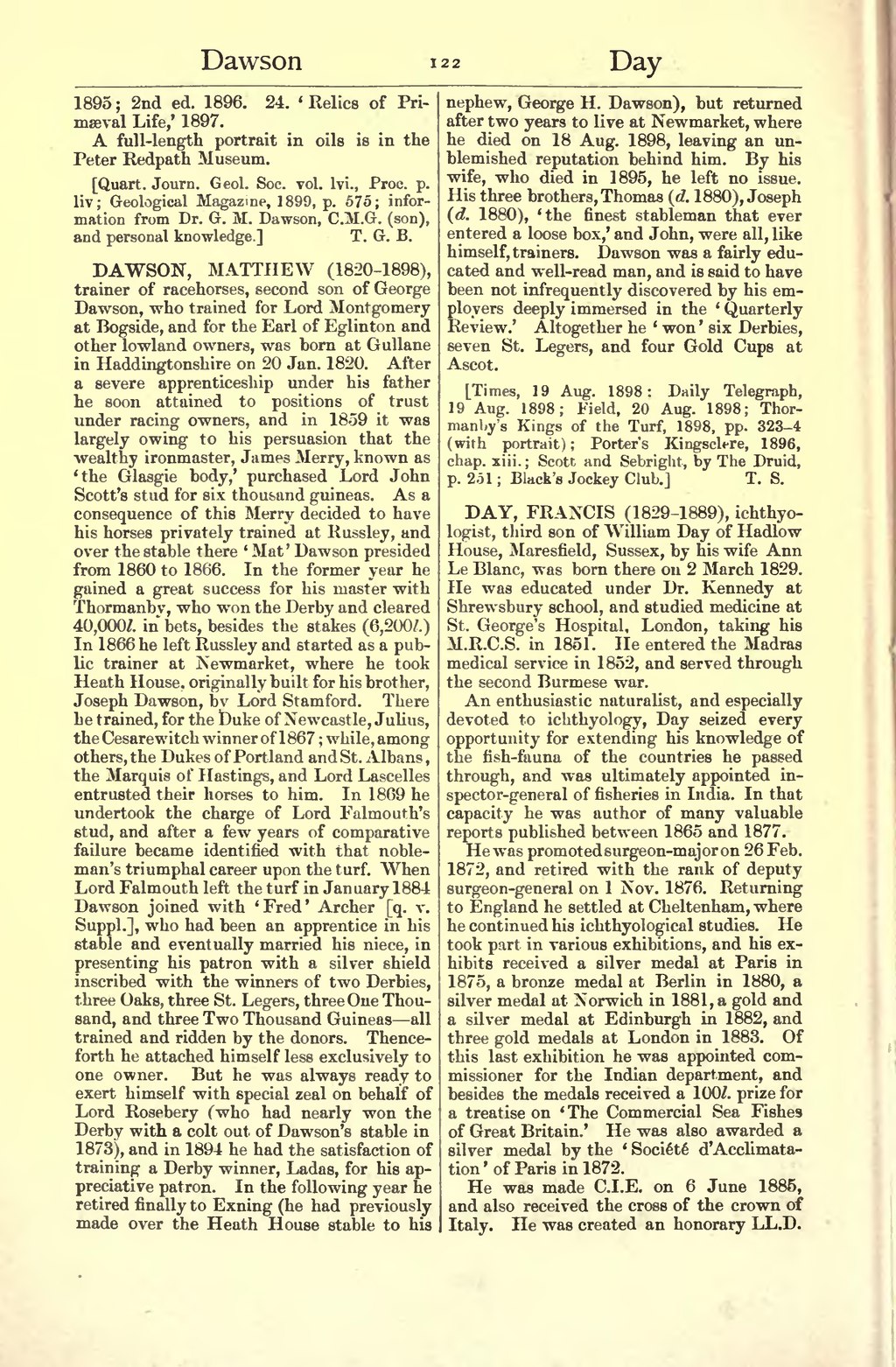-
1895; 2nd ed. 1896.
- 'Relics of Primæval Life,' 1897.
A full-length portrait in oils is in the Peter Redpath Museum.
[Quart. Journ. Geol. Soc. vol. lvi., Proc. p. liv; Geological Magazine, 1899, p. 575; information from Dr. G. M. Dawson, C.M.G. (son), and personal knowledge.]
DAWSON, MATTHEW (1820–1898), trainer of racehorses, second son of George Dawson, who trained for Lord Montgomery at Bogside, and for the Earl of Eglinton and other lowland owners, was born at Gullane in Haddingtonshire on 20 Jan. 1820. After a severe apprenticeship under his father he soon attained to positions of trust under racing owners, and in 1859 it was largely owing to his persuasion that the wealthy ironmaster, James Merry, known as 'the Glasgie body,' purchased Lord John Scott's stud for six thousand guineas. As a consequence of this Merry decided to have his horses privately trained at Russley, and over the stable there 'Mat' Dawson presided from 1860 to 1866. In the former year he gained a great success for his master with Thormanby, who won the Derby and cleared 40,000l. in bets, besides the stakes (6,200l.) In 1866 he left Russley and started as a public trainer at Newmarket, where he took Heath House, originally built for his brother, Joseph Dawson, by Lord Stamford. There he trained, for the Duke of Newcastle, Julius, the Cesarewitch winner of 1867; while, among others, the Dukes of Portland and St. Albans, the Marquis of Hastings, and Lord Lascelles intrusted their horses to him. In 1869 he undertook the charge of Lord Falmouth's stud, and after a few years of comparative failure became identified with that nobleman's triumphal career upon the turf. When Lord Falmouth left the turf in January 1884 Dawson joined with 'Fred' Archer [q. v. Suppl.], who had been an apprentice in his stable and eventually married his niece, in presenting his patron with a silver shield inscribed with the winners of two Derbies, three Oaks, three St. Legers, three One Thousand, and three Two Thousand Guineas all trained and ridden by the donors. Thenceforth he attached himself less exclusively to one owner. But he was always ready to exert himself with special zeal on behalf of Lord Rosebery (who had nearly won the Derby with a colt out of Dawson's stable in 1873), and in 1894 he had the satisfaction of training a Derby winner, Ladas, for his appreciative patron. In the following year he retired finally to Exning (he had previously made over the Heath House stable to his nephew, George H. Dawson), but returned after two years to live at Newmarket, where he died on 18 Aug. 1898, leaving an unblemished reputation behind him. By his wife, who died in 1895, he left no issue. His three brothers, Thomas (d. 1880), Joseph (d. 1880), 'the finest stableman that ever entered a loose box,' and John, were all, like himself, trainers. Dawson was a fairly educated and well-read man, and is said to have been not infrequently discovered by his employers deeply immersed in the 'Quarterly Review.' Altogether he 'won' six Derbies, seven St. Legers, and four Gold Cups at Ascot.
[Times, 19 Aug. 1898: Daily Telegraph, 19 Aug. 1898; Field, 20 Aug. 1898; Thormanby's Kings of the Turf, 1898, pp. 323-4 (with portrait); Porter's Kingsclere, 1896, chap, xiii.; Scott and Sebright, by The Druid, p. 251; Black's Jockey Club.]
DAY, FRANCIS (1829–1889), ichthyologist, third son of William Day of Hadlow House, Maresfield, Sussex, by his wife Ann Le Blanc, was born there on 2 March 1829. He was educated under Dr. Kennedy at Shrewsbury school, and studied medicine at St. George's Hospital, London, taking his M.R.C.S. in 1851. He entered the Madras medical service in 1852, and served through the second Burmese war.
An enthusiastic naturalist, and especially devoted to ichthyology, Day seized every opportunity for extending his knowledge of the fish-fauna of the countries he passed through, and was ultimately appointed inspector-general of fisheries in India. In that capacity he was author of many valuable reports published between 1865 and 1877.
He was promoted surgeon-major on 26 Feb. 1872, and retired with the rank of deputy surgeon-general on 1 Nov. 1876. Returning to England he settled at Cheltenham, where he continued his ichthyological studies. He took part in various exhibitions, and his exhibits received a silver medal at Paris in 1875, a bronze medal at Berlin in 1880, a silver medal at Norwich in 1881, a gold and a silver medal at Edinburgh in 1882, and three gold medals at London in 1883. Of this last exhibition he was appointed commissioner for the Indian department, and besides the medals received a 100. prize for a treatise on 'The Commercial Sea Fishes of Great Britain.' He was also awarded a silver medal by the 'Societé d'Acclimatation' of Paris in 1872.
He was made C.I.E. on 6 June 1885, and also received the cross of the crown of Italy. He was created an honorary LL.D.
